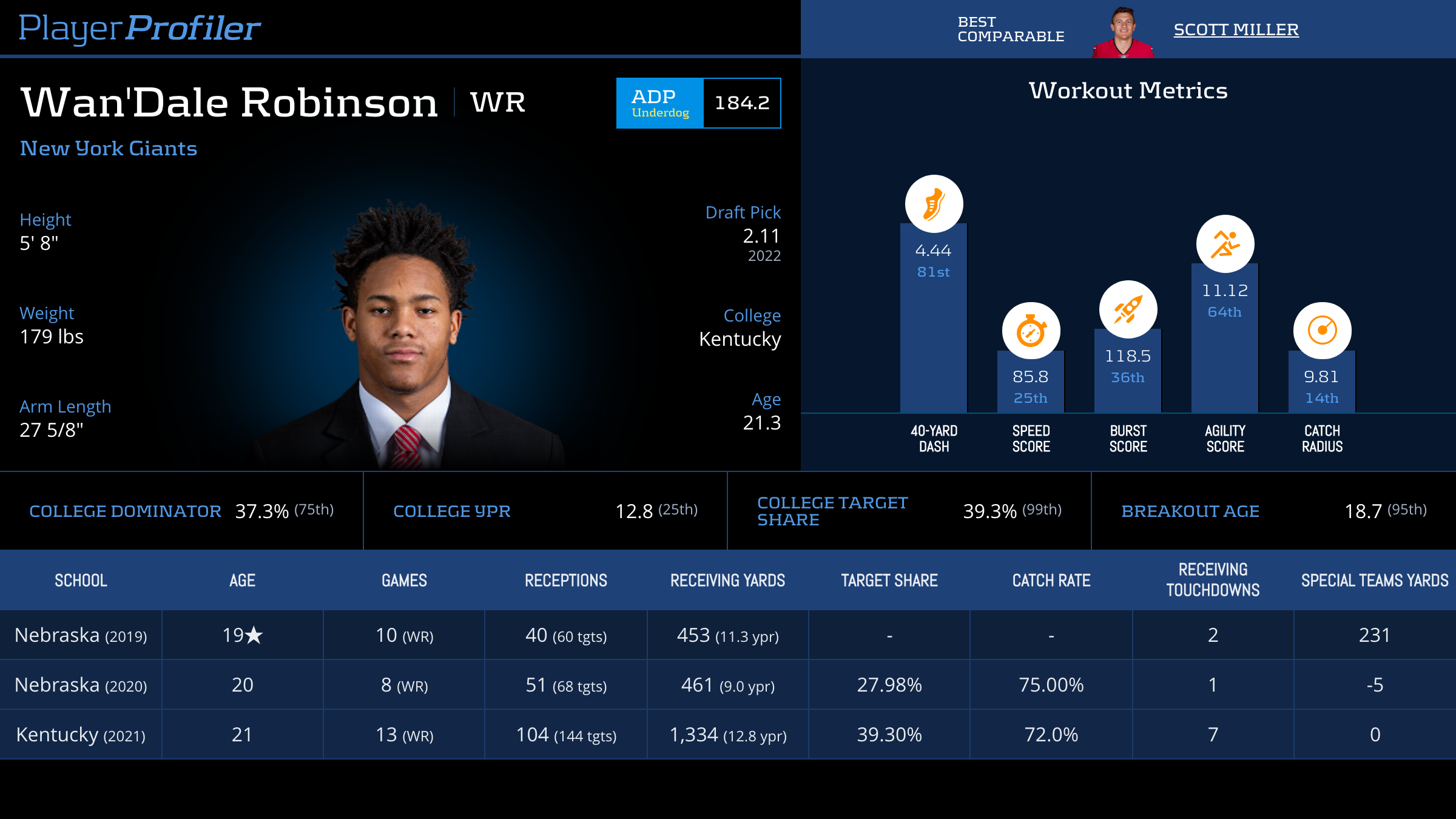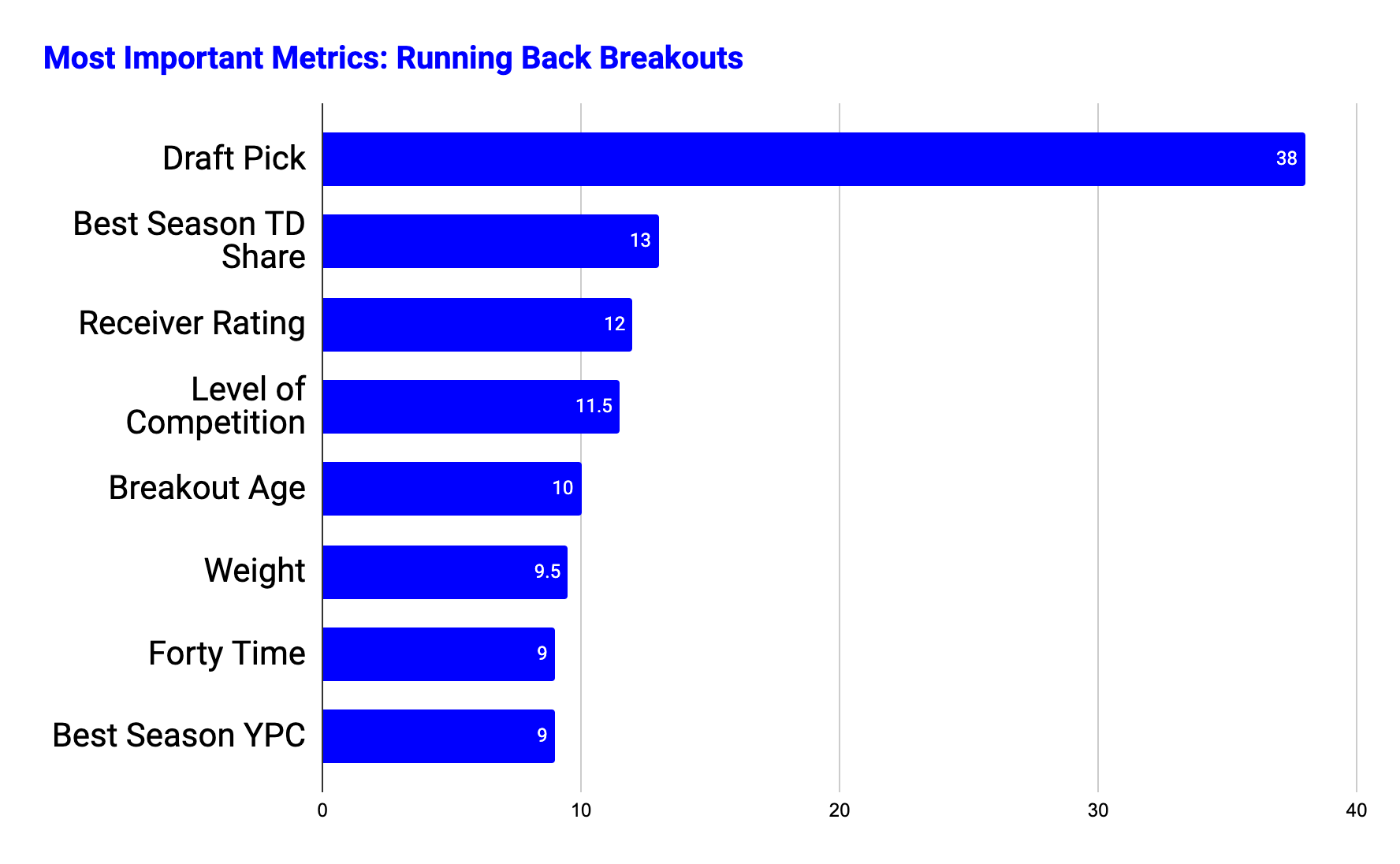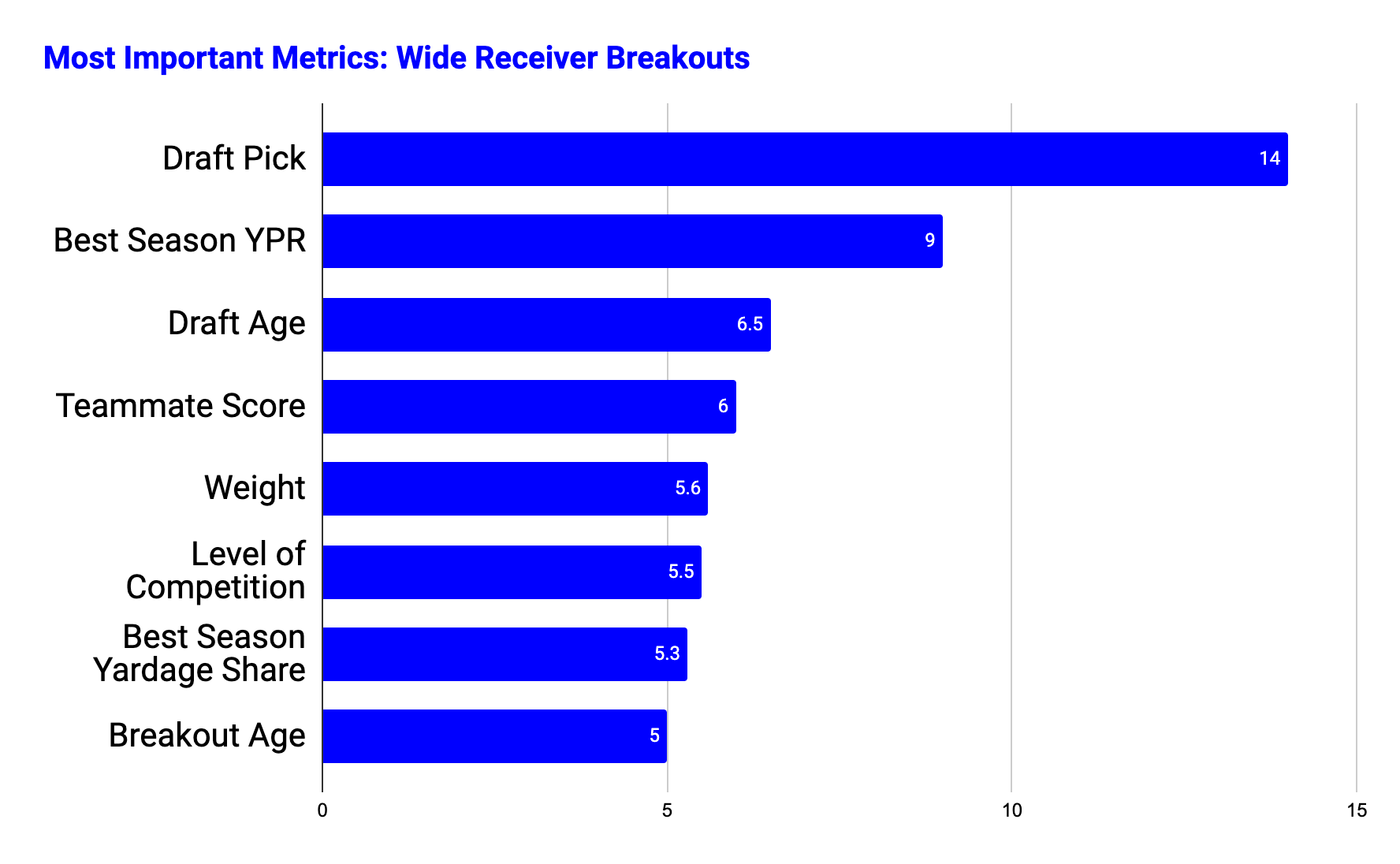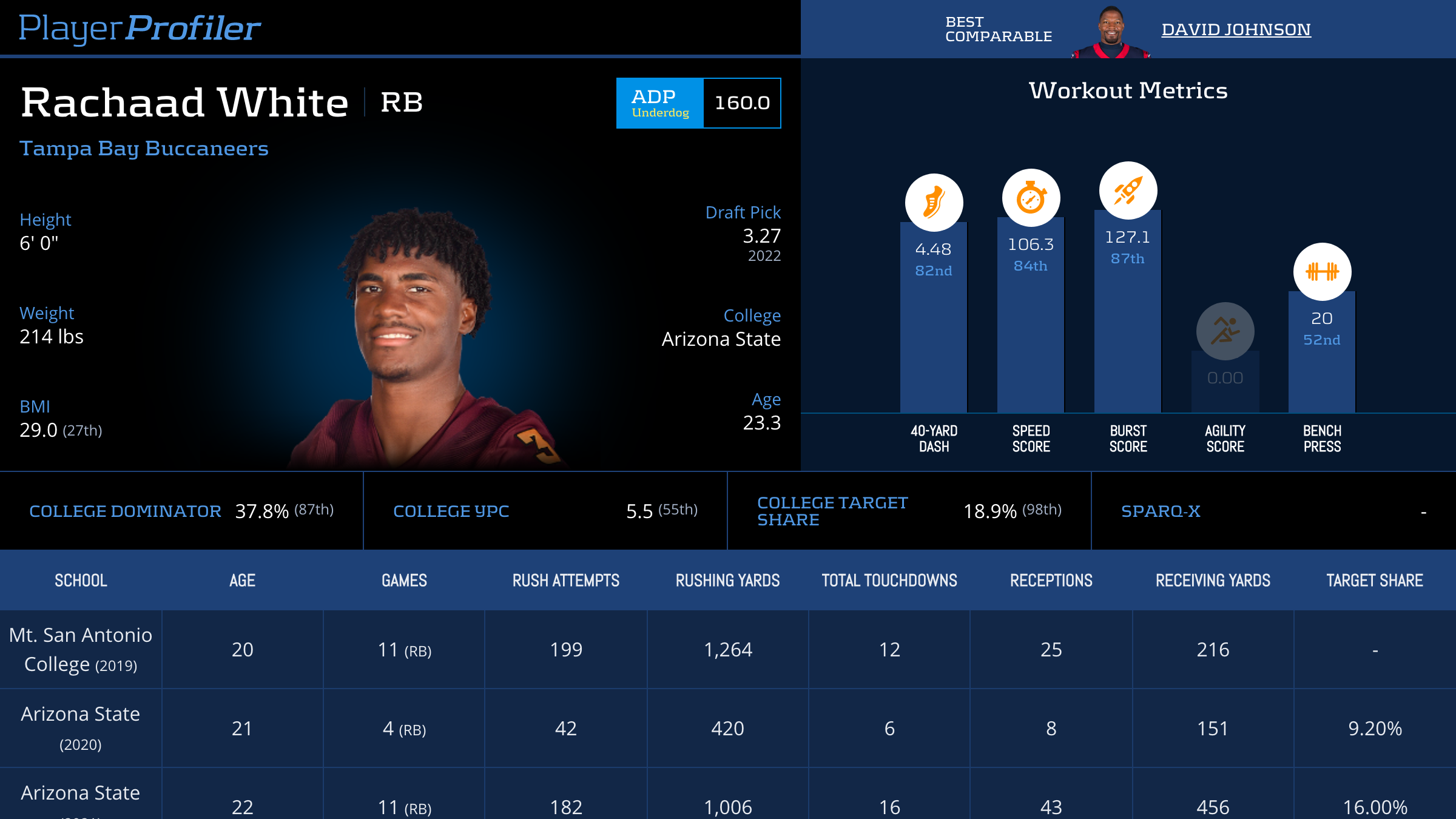The Breakout Finder, a project brought to life by Russell Clay and Nate Liss, is an effort to bridge the gap between analytics and prospect tape using only college football metrics. Many analysts may disagree on conclusions from an NFL prospect’s film. They also disagree or how to interpret their production. The Breakout Finder attempts to eliminate bias. The app uses machine learning to predict how likely a prospect is to have a prominent fantasy season upon their selection (or lack thereof) in the NFL Draft.
Preview
Every summer, the analytics team at PlayerProfiler generates breakout ratings. The team also provides accompanying metrics to describe incoming rookie running backs and wide receivers. The results of the model from years past, as well as the current rookie class, can be viewed in the Breakout Finder application. In this article, we’ll walk through the process of how to interpret the metrics viewable in the app. We will also examine how the breakout model works. You’ll learn what we are using to generate predictions. Also, we’ll highlight some key 2022 running backs and wide receivers that stood out thanks to the results of the model.
Introduction: Model Inputs
Firstly, for the purposes of the project we should define what a breakout is. A breakout is considered to be a fantasy season with at least 200 total fantasy points or 1,000 scrimmage yards. In the 2021 season, rookie Najee Harris easily met both conditions on his way to finishing as the RB4 overall. This earned him a breakout season. PlayerProfiler has access to player data over the past several years. Using the college metrics of every player since 2014 and whether or not they had a breakout season, the breakout finder model uses random forests to evaluate features of a player. Their college metrics predict their ability to break out in the NFL by position.
Metrics
The metrics that are used as inputs to the model are as follows. All of these features can be explored in the application via the metrics database.
Draft metrics
To discover just how much a player’s draft capital is predictive of their fantasy success in the NFL, we use both their overall pick number and the age at which they were drafted to train the model
Size
We hypothesize that height and weight play a role in a player’s ability to break out, and we want to discover how much so for each position.
40-yard time
We evaluate how meaningful a player’s pure speed at the NFL Combine affects their future ability to produce a breakout season.
Breakout age
On PlayerProfiler, a prospect’s dominator rating accounts for the share of touchdowns and yardage they command within their own offense. Breakout age is the age in which a receiver reaches a 20-percent dominator rating for the first time. Producing at a young age is a solid indication that a player will continue his stretch of production into the pros.
Early declare
History, wide receivers who declare for the NFL draft early are most likely to find themselves among the league’s best producers. For statistical reference, consider the charts below that compare fantasy finishes of running backs and wide receivers who declared early against those who did not. The question the breakout finder model attempts to answer is—how predictive is the binary early declare metric of elite fantasy production?


(Tables via Sharp Football Analytics)
College performance
With access to several advanced metrics related to college performance, we train the model with players’ best yardage share, yards per reception, freshman yardage share in a single college season.
- Four additional statistics: dynamic score, teammate score, level of competition, receiver rating (running backs only).
The additional statistics are available in the app separately to be unlocked and are briefly described in the Breakout Finder Glossary.
Dynamic Score
This metric is to encompass how diverse and elusive an athlete is. The metric combines special teams returns as well as rushing yardage. Notable former prospects in this department include active wide receiver Curtis Samuel. Samuel’s 133.4 score ranks No. 7 all-time. Percy Harvin, whose score is 185.2, makes him the all-time dynamic score king. A dynamic score of above 100 puts a prospect among the all-time elites in the category.
As noted in the aforementioned article by Aaron Stewart, dynamic score matters for prospects’ opportunity in the NFL. The high dynamic scores at the wide receiver position generally get a shot to compete for fantasy relevance with their NFL team. However, dynamic score is not the sole predictor of success and finishing as a top-tier fantasy player. Hence, the breakout finder model to determine importance.
Notable 2022 player: Wan’Dale Robinson
While none of the wide receiver prospects of this year’s class stand out as an all-timer, Kentucky’s Wan’Dale Robinson led this year’s bunch in dynamic score with a solid 45.8. This is eerily similar to the 42.4 posted by Kadarius Toney. Toney is now a teammate of Robinson with the New York Giants.

The top wide receiver of the class, Drake London, did not see relevance in this category. London posted a 0.2 dynamic score. Several early draft picks at the position such as Christian Watson, John Metchie, George Pickens, Alec Pierce, Velus Jones, and Jalen Tolbert posted a dynamic score of 0.0. This is the lowest number possible.
Teammate Score
In an attempt to put the raw college production of a player into context, we must account for the other members of the offense they are competing with for an opportunity share. The teammate score of a prospect accounts for individual teammates that a prospect played with. The metric serves as an empirical way to address the skill position players around a prospect and converting it into one composite score. For example, prospects on the most stacked offensive-talent teams appear atop the all-time leaderboards in the metric.
Did you know, DeVonta Smith has the #1 Teammate Score of ALL-TIME!
Created by @RussellJClay – The teammate score accounts for each individual teammate that a prospect played with to put true context on opportunity share.
Get the BreakoutFinder App: https://t.co/FKpFe8UZ95 pic.twitter.com/2JlFxvkOAX
— PlayerProfiler College (@Profiler_CFB) June 5, 2022
Devonta Smith, who played with NFL talents like Najee Harris, Jaylen Waddle, and 2022 prospects Brian Robinson Jr. (running back), Slade Bolden (wide receiver), and John Metchie (wide receiver), is the current all-time leader in teammate score.
Unsurprisingly, Robinson leads the 2022 class by a significant margin in teammate score. Fifth-round draftee Jerome Ford (Alabama, Cincinnati) and second-round draftee James Cook (Georgia) follow as runners-up at the running back position.
The wide receivers are topped out by undrafted prospects Slade Bolden (Alabama) and Dahu Green (Arkansas). The top drafted prospect is John Metchie (Alabama) but not far behind is first-rounder Chris Olave (Ohio State). Olave could see a path to earning himself an alpha role early on for the New Orleans Saints given the uncertain future of Michael Thomas.
Receiver Rating
For running backs, we want to separately account for their talent at receiving the football. We hypothesize that running back prospects who produce for their college offense through the air are more likely to provide fantasy relevance in the NFL. This metric takes into account the best season for a prospect in these four statistics: target share, yards per team pass attempt, yards per receptions, and team yardage share. The receiver rating of a player is then computed with respect to their class by averaging their percentile rank (0 to 100) for each of those four metrics.
Notable 2022 Player: Rachaad White
A 23-year-old from Arizona State, Rachaad White has impressive metrics and measurables across the board. However, his receiving game is what puts him in a tier of his own. White ranked No. 1 in the class in best target share in a season (18.9-percent). He also posted the best yards per team pass attempt in a season (1.74). He also ranked in the 90th-percentile in best yards per reception in a season (18.88) and 98th-percentile in best team yard share in a season (19.4-percent). White earned a 97.13 receiver rating. This wasn’t just the leader of his class, but the highest of any running back since 2010.
While the Breakout Finder computes metrics objectively without projecting for landing spots, it is noteworthy that the 2022 king of receiver rating has now landed a home with the Tampa Bay Buccaneers. White will now look to earn targets from Tom Brady. His primary competition will be a reportedly overweight Leonard Fournette.
Breakout Finder Results: Running Backs
Using random forest machine learning algorithms on breakout players over the last 15 years, we predicted how likely an incoming prospect is to have a breakout season given their aforementioned attributes. In the process, we generated GINI importance numbers for each parameter. This number shows us which metrics were most telling for running back breakouts. Pictured below are the top results.

It’s not a surprise that draft capital is extremely important to predicting breakouts at the running back position. After all, there is inherent correlation here. Elite producers in college are more likely to produce in the NFL but are also more likely to be drafted earlier. Indeed, over the past 15 years of data, there have been 72 running backs to have a breakout season. Of those, 47 have been selected in the top 100 of the NFL draft and only 11 of them went undrafted.
Using the Breakout Finder to find value in Rookie Drafts | The Futurecast https://t.co/XdUgG3D15z
— ᴄᴏᴅʏ ᴄᴀʀᴘᴇɴᴛɪᴇʀ (@CodyCarpentier) May 11, 2022
Most notably, height and draft age are variables that do not deem relatively important to predicting running back breakouts. Instead, peak team touchdown share, and our concocted receiver rating metric deem to be the most important among the raw college metrics.
Other Notes
Some notes from this year’s rookie running back breakout rating results:
- Only one drafted player has a rating below 15.0: Kyren Williams (Rams).
- Only one undrafted player has a rating above 15.0: Julius Chestnut (Titans).
- The player with the lowest receiver rating of the class Tyrion Davis-Price (49ers). He still graded top 10, thanks to an early declare and a top five teammate score (92.9), playing with the Joe Burrow LSU Tigers, alongside Clyde Edwards-Helaire, Terrace Marshall Jr., Ja’Marr Chase, and Justin Jefferson.
Breakout Finder Results: Wide Receivers
Once again, we generated the GINI importance of all our input parameters to express which features tended to be most important in predicting breakouts. This time we analyzed the data for wide receivers using metrics spanning over the previous eight years.

Yet again, draft capital is a strong tell for fantasy success. In the last eight years, there have been 44 wide receivers to have a breakout season. Of them, 13 were first-round draft picks and unlike the running back position, no undrafted players posted a breakout season.
Weight
Notably, weight proves to be among the key factors in determining breakouts for both running backs and wide receivers. Where the positions differ, however:
- Forty times do not matter! The usefulness of the NFL combine 40-yard dash has often been debated. For fantasy breakout seasons, forty times do not appear as relevant for our model. This was not the case for running backs.
- Draft age does matter. While this parameter was unimportant for running back predictions, it appears here as the third-most-important feature for wide receivers.
Best Metric
The most important raw college metric for wide receivers in our model is the best yards per reception in a season for a wide receiver. Indeed, efficiency in producing yards should translate to production at the NFL level. The most extreme examples of this include are the four wide receivers in our eight-year database who posted higher than 20 yards per reception in their best season and went on to break out. They are D.J. Chark, CeeDee Lamb, Ja’Marr Chase, and Mike Evans.
How Important is Teammate Score?
Finally, it is important to note how important the created metric teammate score is. Earning targets is a sign of talent and earning them in the midst of greatness prepares you for earning targets at the NFL level. Of the top 12 teammate score players in the database, five of them cashed in the NFL with a breakout season. Those players are Jaylen Waddle, Tee Higgins, Justin Jefferson, Curtis Samuel, and Ja’Marr Chase. Two other names in the top 12 remain in contention for a future breakout season. These players are Devonta Smith (No. 1) and Jerry Jeudy (No. 3).
Other Notes
Some notes from this year’s rookie wide receiver breakout rating results:
- Three of the top 10 wide receivers in teammate score were also drafted in the first round. These players are consecutive picks Garrett Wilson (Jets), Chris Olave (Saints), and Jameson Williams (Lions). Unsurprisingly, they did not disappoint in this year’s breakout rating model.
- Four wide receivers not drafted in the first-round rank top 20 in the class in best season yards per perception. These players are Christian Watson (Packers), George Pickens (Steelers), Alec Pierce (Colts), and Jalen Tolbert (Cowboys). All of them posted a higher peak yards per reception than first-rounders Drake London and Chris Olave.
Conclusion
In conclusion, the results of the breakout finder should aid fantasy managers in recognizing what college metrics are effective identifiers of talent. Coupled with their landing spots, there continues to be value in drafts in the rookie market. A rookie running back has finished top 15 at the position in fantasy football in ten straight seasons. And more often than not, a rookie wide receiver heavily outproduces their ADP. Head over to Underdog Fantasy and continue beating the best ball boards using promo code UNDERWORLD.



